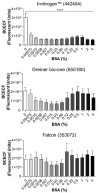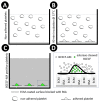Standardization and Validation of Fluorescence-Based Quantitative Assay to Study Human Platelet Adhesion to Extracellular-Matrix in a 384-Well Plate
- PMID: 32906775
- PMCID: PMC7554887
- DOI: 10.3390/ijms21186539
Standardization and Validation of Fluorescence-Based Quantitative Assay to Study Human Platelet Adhesion to Extracellular-Matrix in a 384-Well Plate
Abstract
Platelets play a crucial role in the immunological response and are involved in the pathological settings of vascular diseases, and their adhesion to the extracellular matrix is important to bring leukocytes close to the endothelial cells and to form and stabilize the thrombus. Currently there are several methods to study platelet adhesion; however, the optimal parameters to perform the assay vary among studies, which hinders their comparison and reproducibility. Here, a standardization and validation of a fluorescence-based quantitative adhesion assay to study platelet-ECM interaction in a high-throughput screening format is proposed. Our study confirms that fluorescence-based quantitative assays can be effectively used to detect platelet adhesion, in which BCECF-AM presents the highest sensitivity in comparison to other dyes.
Keywords: 384-well plate; BCECF-AM; extracellular matrix; fluorescence-based quantitative assay; high-throughput screening assay; platelet adhesion.
Conflict of interest statement
The authors declare no conflict of interest. The funders had no role in the design of the study; in the collection, analyses, or interpretation of data; in the writing of the manuscript, or in the decision to publish the results.
Figures







Similar articles
-
Increased neonatal platelet deposition on subendothelium under flow conditions: the role of plasma von Willebrand factor.Pediatr Res. 1999 Feb;45(2):270-5. doi: 10.1203/00006450-199902000-00019. Pediatr Res. 1999. PMID: 10022601
-
Platelet adhesion and aggregate formation in type I diabetes under flow conditions.Diabetes. 1991 Nov;40(11):1410-7. doi: 10.2337/diab.40.11.1410. Diabetes. 1991. PMID: 1936602
-
Extracellular matrix proteins in hemostasis and thrombosis.Cold Spring Harb Perspect Biol. 2012 Feb 1;4(2):a005132. doi: 10.1101/cshperspect.a005132. Cold Spring Harb Perspect Biol. 2012. PMID: 21937733 Free PMC article. Review.
-
Desmopressin (DDAVP) enhances platelet adhesion to the extracellular matrix of cultured human endothelial cells through increased expression of tissue factor.Thromb Haemost. 1997 May;77(5):975-80. Thromb Haemost. 1997. PMID: 9184413
-
Adhesion mechanisms in platelet function.Circ Res. 2007 Jun 22;100(12):1673-85. doi: 10.1161/01.RES.0000267878.97021.ab. Circ Res. 2007. PMID: 17585075 Review.
Cited by
-
From the teapot effect to tap-triggered self-wetting: a 3D self-driving sieve for whole blood filtration.Microsyst Nanoeng. 2023 Mar 21;9:30. doi: 10.1038/s41378-023-00490-7. eCollection 2023. Microsyst Nanoeng. 2023. PMID: 36960347 Free PMC article.
References
-
- Frenette P.S., Denis C.V., Weiss L., Jurk K., Subbarao S., Kehrel B., Hartwig J.H., Vestweber D., Wagner D.D. P-Selectin Glycoprotein Ligand 1 (Psgl-1) Is Expressed on Platelets and Can Mediate Platelet–Endothelial Interactions in Vivo. J. Exp. Med. 2000;191:1413–1422. doi: 10.1084/jem.191.8.1413. - DOI - PMC - PubMed
MeSH terms
Grants and funding
LinkOut - more resources
Full Text Sources

